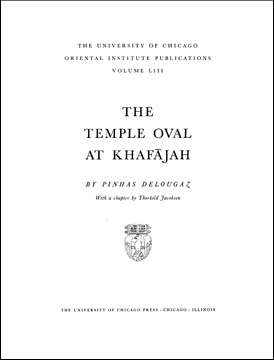OIP 53.

The Temple Oval at Khafajah
Pinhas Delougaz, with a chapter by Thorkild Jacobsen.
The carefulmess of detail and absence of theoretical speculation in this description of a building complex rare in the history of excavation set an excellent example for future excavators. The numerous photographs admirably complement the text, and a catalogue of the objects found give the locus and relative date of each, as well as reference to the other volumes of the series in which they have been or will be more fully treated.
Perhaps the most interesting aspect of the temple oval, aside from its shape, is the fact that to accommodate its foundations some 64,000 cubic metres of soil were removed and replaced with the same amount of sand, underlying the whole of the temple oval. On top of the sand, after the foundations of the walls had been laid, was packed a solid layer of clay, sealing in the walls. Not only does this undertaking reflect an engineering and architectural skill unsuspected for the Early Dynastic period, but also throws increased light on the economy of the time, for even under the Hittite and Roman Empires temple-builders were content with sand- or pebble-filled trenches beneath the actual foundation walls, as at Tarsus and Troy.
- Oriental Institute Publications 53
- Chicago: The University of Chicago Press, 1940
- Pp. xix + 175; Frontispiece; 126 figures; 12 plates
- Hardbound 9 x 12 inches
- Out of Print

